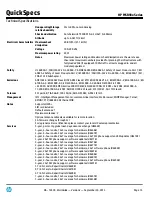
4G LTE Verizon and global carrier support
delivers embedded 4G LTE wireless WAN backhaul connectivity with two different carrier chipset options
Multiple advanced WAN interfaces
provides traditional connection options including serial, ADSL2+ (Annex A/M, Annex B/J, over POTS or ISDN), 4-pair G.SHDSL and
WAN Gigabit Ethernet ports; offers wireless access with 4G LTE and 3G connectivity
Performance
Forwarding performance
provides up to 300 Kpps; meets current and future bandwidth-intensive application demands for enterprise businesses
Embedded encryption
supports up to 100 VPN tunnels and up to 160 Mbps encryption throughput
Gigabit Ethernet interface
provides a connection to the network that eliminates the network as a bottleneck
Resiliency and high availability
Backup Center
acts as a part of the management and backup function to provide backup for device interfaces; delivers reliability by switching
traffic over to a backup interface when the primary one fails
Virtual Router Redundancy Protocol (VRRP)
allows groups of two routers to dynamically back each other up to create highly available routed environments; supports VRRP
load balancing
Wireless WAN (WWAN) with integrated 3G
allows small-branch users to maintain remote office data connectivity to data center or headquarters using the integrated
carrier connections
Layer 2 switching
Spanning Tree Protocol (STP)
supports standard IEEE 802.1D STP, IEEE 802.1w Rapid Spanning Tree Protocol (RSTP) for faster convergence, and IEEE 802.1s
Multiple Spanning Tree Protocol (MSTP)
Internet Group Management Protocol (IGMP) and Multicast
Listener Discovery (MLD) protocol snooping controls and manages the flooding of multicast packets in a Layer 2 network
Port mirroring
duplicates port traffic (ingress and egress) to a local or remote monitoring port
Port isolation
increases security by isolating ports within a VLAN while still allowing them to communicate with other VLANs
VLANs
supports IEEE 802.1Q-based VLANs
sFlow
allows traffic sampling
Layer 3 services
Address Resolution Protocol (ARP)
determines the MAC address of another IP host in the same subnet; supports static ARPs; gratuitous ARP allows detection of
duplicate IP addresses; proxy ARP allows normal ARP operation between subnets or when subnets are separated by a Layer 2
network
Dynamic Host Configuration Protocol (DHCP)
simplifies the management of large IP networks and supports client and server; DHCP Relay enables DHCP operation across
QuickSpecs
HP MSR93x Series
Overview
DA - 14559 Worldwide — Version 2 — September 30, 2013
Page 3


















